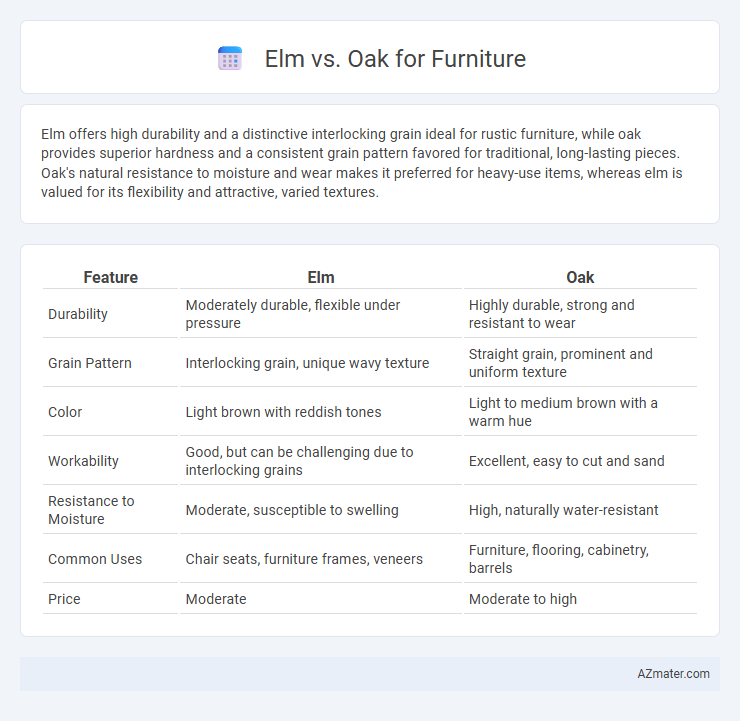Elm offers high durability and a distinctive interlocking grain ideal for rustic furniture, while oak provides superior hardness and a consistent grain pattern favored for traditional, long-lasting pieces. Oak's natural resistance to moisture and wear makes it preferred for heavy-use items, whereas elm is valued for its flexibility and attractive, varied textures.
Table of Comparison
| Feature | Elm | Oak |
|---|---|---|
| Durability | Moderately durable, flexible under pressure | Highly durable, strong and resistant to wear |
| Grain Pattern | Interlocking grain, unique wavy texture | Straight grain, prominent and uniform texture |
| Color | Light brown with reddish tones | Light to medium brown with a warm hue |
| Workability | Good, but can be challenging due to interlocking grains | Excellent, easy to cut and sand |
| Resistance to Moisture | Moderate, susceptible to swelling | High, naturally water-resistant |
| Common Uses | Chair seats, furniture frames, veneers | Furniture, flooring, cabinetry, barrels |
| Price | Moderate | Moderate to high |
Introduction to Elm and Oak Wood
Elm wood is valued for its interlocking grain, which provides exceptional resistance to splitting and makes it ideal for curved furniture designs. Oak wood, known for its dense and coarse texture, offers superior hardness and durability, making it a preferred material for sturdy and long-lasting furniture pieces. Both hardwoods exhibit unique grain patterns and color variations, enhancing the aesthetic appeal of crafted furniture.
Botanical Characteristics of Elm and Oak
Elm trees belong to the Ulmus genus, known for their serrated, oval-shaped leaves with asymmetrical bases and rough texture, contributing to distinctive grain patterns in furniture. Oak, from the Quercus genus, features lobed or pointed leaves with a smooth to slightly rough texture, producing dense, strong wood with prominent ray flecks ideal for durable furniture design. Both trees exhibit hardwood properties, yet Oak's slower growth results in tighter grain and greater hardness compared to Elm's lighter, more flexible wood.
Durability: Elm vs Oak
Oak wood exhibits superior durability compared to elm, making it a preferred choice for furniture intended to withstand heavy use and last for decades. Elm is moderately durable but less resistant to wear and dents due to its open grain structure, which tends to be softer than oak's dense, interlocked grain. Oak's high resistance to moisture and fungal attack further enhances its longevity in furniture applications, surpassing elm's performance in durability.
Workability and Crafting Ease
Elm wood offers excellent workability due to its interlocked grain and moderate hardness, making it easier to carve and shape for detailed furniture designs. Oak, being denser and harder, requires more effort when cutting and sanding but provides superior durability and a refined finish suitable for robust furniture pieces. Craftsmen often favor elm for intricate work and oak for projects demanding longevity and structural strength.
Visual Appeal: Grain and Color Comparison
Elm furniture showcases an attractive interlocking grain pattern with light to medium brown hues, often featuring streaks of yellow and reddish tones that enrich its visual warmth. Oak offers a more pronounced, coarse grain texture with a range from light tan to medium brown, occasionally exhibiting subtle reddish undertones that enhance its classic and sturdy appearance. Both woods provide distinct aesthetics, with elm's wavy grain creating a dynamic, organic look while oak's prominent grain emphasizes rustic durability.
Resistance to Moisture and Decay
Elm wood exhibits strong resistance to moisture due to its interlocking grain, making it less prone to warping and swelling in damp environments. Oak, particularly white oak, offers superior decay resistance because of its dense cellular structure and high tannin content, which effectively repel fungi and insects. For furniture exposed to moisture, white oak is generally preferred for outdoor or humid settings, while elm suits indoor applications where moderate moisture exposure occurs.
Common Furniture Uses for Elm and Oak
Elm is commonly used for making durable chairs, tables, and cabinets due to its interlocking grain that resists splitting. Oak is favored for heavy furniture such as flooring, cabinets, and sturdy dining tables because of its strong, hard-wearing nature and prominent grain. Both woods provide excellent stability and aesthetic appeal, with elm offering more flexibility and oak delivering superior strength.
Cost Comparison: Elm versus Oak
Elm furniture generally offers a more cost-effective option compared to oak, with prices often 20-30% lower due to its quicker growth rate and wider availability. Oak, known for its durability and rich grain patterns, commands higher prices driven by slower growth cycles and greater demand in premium furniture markets. Budget-conscious buyers seeking solid hardwood furniture find elm a suitable alternative to oak without compromising structural integrity.
Sustainability and Environmental Impact
Elm wood is highly sustainable due to its fast growth rate and natural resistance to pests and decay, reducing the need for chemical treatments. Oak, while slower-growing, offers exceptional durability and can last generations, minimizing the frequency of replacement and overall environmental footprint. Both woods sequester carbon effectively, but elm's quicker regeneration cycle often makes it a more eco-friendly choice for environmentally conscious furniture production.
Choosing the Right Wood for Your Furniture
Elm wood offers exceptional durability and resistance to splitting, making it ideal for furniture that requires strength and longevity. Oak wood stands out for its pronounced grain and hardness, providing both aesthetic appeal and robust wear resistance in high-traffic pieces. Selecting between elm and oak hinges on balancing Elm's flexibility and shock resistance against Oak's classic look and superior hardness for your furniture needs.

Infographic: Elm vs Oak for Furniture
 azmater.com
azmater.com